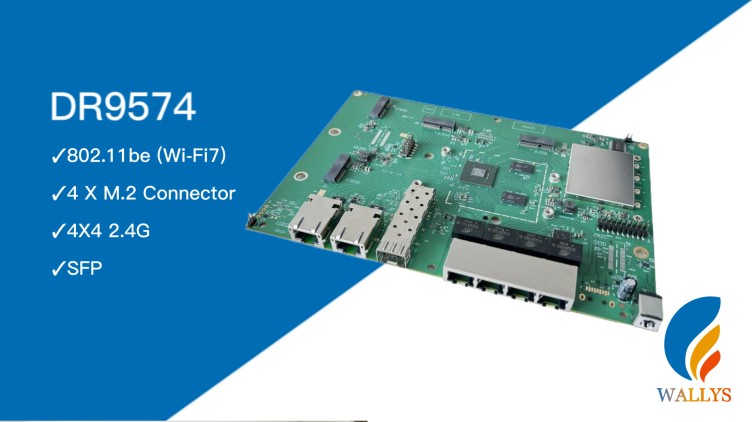|
|
IPQ5322 and IPQ9531-Technical comparison and application analysis
IPQ5322 and IPQ9531 are two system-on-chip (SoC) developed by Qualcomm for network devices, mainly used in routers, gateways, access points and other network devices. Although they are all based on Qualcomm's network technology platforms, there are significant differences in performance, functionality, design goals, and more. This article will explore the differences between the two chips in detail to help readers better understand and choose a solution that suits their needs.
1. Chip architecture
#### IPQ5322
The IPQ5322 is a mid-market SoC designed primarily for use in small and medium-sized businesses and high-end home routers. Its structure includes:
- **CPU:** dual-core ARM Cortex-A53, clock rate up to 1.4GHz.
- ** Memory support :** Support DDR3/DDR3L/DDR4, the maximum memory capacity up to 2GB.
- ** Wireless networking :** Supports Wi-Fi 5 (802.11ac Wave 2), provides 2x2 MU-MIMO configuration, and reaches a maximum throughput of 1.2Gbps.
- ** Network interface :** Integrates a Gigabit Ethernet switch to support multiple LAN/WAN ports.
- ** Hardware acceleration :** Includes hardware NAT acceleration and hardware encryption engine to improve data processing efficiency and security.
#### IPQ9531

The IPQ9531 is targeted at the more high-end market, suitable for enterprise-class network equipment and high-performance routers. Its architecture has the following features:
- **CPU:** quad-core ARM Cortex-A53, clock rate up to 2.0GHz.
- ** Memory support :** Support DDR4, the maximum memory capacity up to 4GB.
- ** Wireless networking :** Supports Wi-Fi 6 (802.11ax) and offers 4x4 MU-MIMO configuration with a maximum throughput of 4.8Gbps.
- ** Network interface :** Integrates a multi-port 10Gbps Ethernet switch, supports multiple LAN/WAN configurations, and ADAPTS to higher bandwidth requirements.
- ** Hardware acceleration :** More powerful hardware NAT acceleration and hardware encryption engine, while supporting more security protocols and virtual network features (such as VPNS).
Second, performance comparison
- **CPU performance :** The quad-core architecture of the IPQ9531 and the higher clock rate make it far more computing power than the IPQ5322. Multi-core design not only improves overall performance, but also enhances multitasking capabilities.
- ** Wireless Performance :** IPQ9531 supports the latest Wi-Fi 6 standard with higher throughput and better multi-user experience (MU-MIMO). In contrast, the Wi-Fi 5 performance of the IPQ5322 is low, and is suitable for environments with low wireless performance requirements.
- ** Memory Support :** IPQ9531 supports higher speed and large capacity DDR4 memory, helping to improve data processing speed and system responsiveness. The IPQ5322's memory support is relatively weak, but it still meets the needs of the mid-market.
3. Application scenarios
#### IPQ5322
- ** Home Router :** Suitable for high-end home environments, providing good wireless coverage and high network speeds.
- ** Small and medium-sized enterprises :** Meet the basic needs of small and medium-sized enterprises for network equipment, support multiple devices at the same time.
- ** High cost performance :** provides a cost-effective choice for users with limited budgets, with good performance and features.
#### IPQ9531
- ** Enterprise-class router :** Suitable for large and medium-sized enterprises, supporting the high performance network connection needs of a large number of devices.
- ** High-traffic scenarios :** Performs well in application scenarios requiring high bandwidth and low latency, such as video conferencing and data centers.
- ** Future scalability :** Supports the latest network standards and higher memory capacity, ensuring that the device will maintain good performance for years to come.
4. Conclusion
Although both IPQ5322 and IPQ9531 are network SoCs provided by Qualcomm, their target markets and application scenarios are significantly different. The IPQ5322 is targeted at the mid-market, offering good performance and cost performance, suitable for households and small and medium-sized enterprises. The IPQ9531 is aimed at the high-end market, with more powerful performance and higher scalability, suitable for enterprise-class networks and high-traffic demand scenarios. Which chip to choose depends on the specific needs and budget of the user.
Wallys software technology advantages:
Wallys has 10 years of experience in software development and is very experienced in uboot, Linux, wifi protocol, wifi performance, OS and other systems. It mainly uses Qualcomm chips to develop important software such as drivers and kernels, and has the ability to modify and compile to meet customers' different wifi functional requirements. Meanwhile, it participates in openwrt organization and code development. wifi5 product DR40x9 has been officially supported by openwrt.
Hardware technology advantages:
We have a strong hardware design team, and experienced people know that the most difficult part of hardware design is RF circuit design, baseband, etc., while wallys team made 0 error to achieve signal integrity, such as frequency conversion of network card, from 2.4G to 900M, which is a technological breakthrough.
Clients: TIP,Facebook, Openwrt, etc
Email:sales@wallystech.com
WEB:https://www.wallystech.com/
|
|